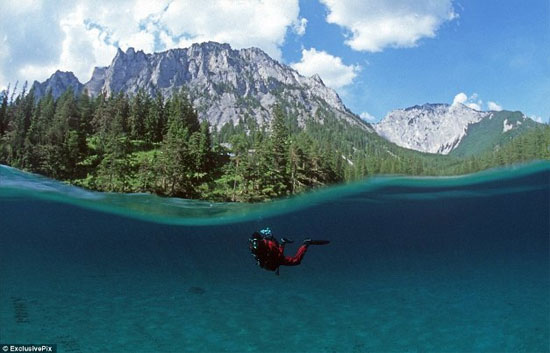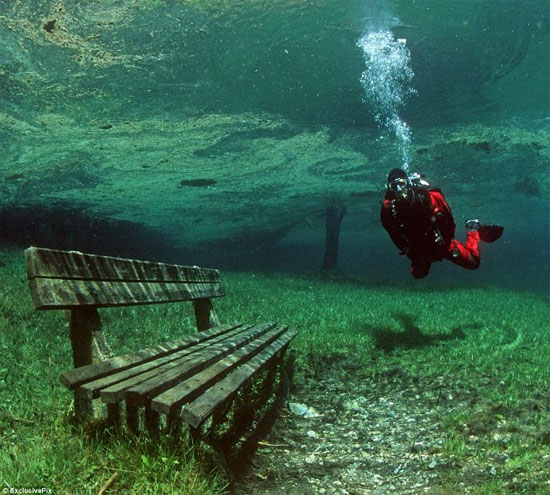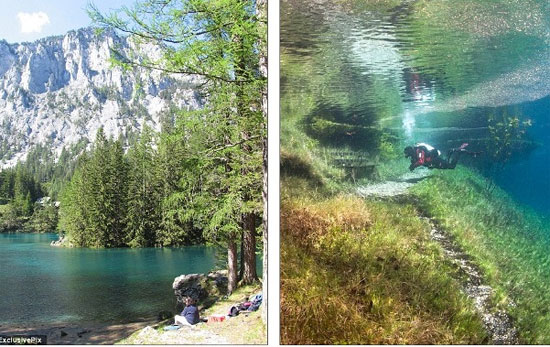Every summer park turns into a lake
Lake Grüner See, also known as the Blue Lake, is located at the foot of the Hochschwab snow-capped mountain, near the Austrian town of Tragoss. During the winter months, the lake is only 1-2 meters deep, and the surrounding areas are used as a park. But in summer, the water level rises to 12m.
Green Lake Park is especially a favorite place for people walking. But when the temperature started to rise in the spring, the ice and snow on the top of the mountain began to melt and follow the mountainside, pouring into the lake. The lake gradually increased the amount of water and covered the entire surrounding area including the park. By summer, the amount of water in the lake reached a record level with a depth of about 12m. June is the time when the Lake Grüner See is considered the most beautiful.

Lake Grüner See has a distinctive blue color thanks to the grass, trees and leaves on the bottom, along with completely transparent ice melting from the snow. The temperature of the lake is quite cold, about 4-8 degrees Celsius and this time, it becomes an attractive place for divers. The grass and flowers are still intact, and bloom even when under water. Visitors can also see chairs, bridges and walking paths.
Entering July, the lake began to drain, and in winter, the lake returned to its original size; and Lake Blue Park is back to the familiar point of people walking .


Left photo: Blue Lake and the park in the autumn and winter months
Right: Visit another park in a summer style

Swim between two bushes

In the summer this road becomes useless




Blue Lake returns to its original form in winter
- The dry park turns into a beautiful lake in the summer
- Strangely, the lake turns blood red in Turkey
- Desert phenomenon turns into thousands of blue pools
- The strange lake contains millions of rainbow-colored stones
- The lake boils all year round on the island of Dominica
- The cleanest lake in the world
- The lake of Iranian salt water turned red like blood
- Mysterious lake color change
- 8 prone skin diseases in summer heat
- The hexagonal cloud on Saturn turns yellow when the season is over
- Lake Turkana National Park - Kenya
- The culprit made the
 Is the magnetic North Pole shift dangerous to humanity?
Is the magnetic North Pole shift dangerous to humanity? Washington legalizes the recycling of human bodies into fertilizer
Washington legalizes the recycling of human bodies into fertilizer Lightning stone - the mysterious guest
Lightning stone - the mysterious guest Stunned by the mysterious sunset, strange appearance
Stunned by the mysterious sunset, strange appearance Discover the mystery behind the world's roundest natural lake
Discover the mystery behind the world's roundest natural lake  Mysterious wonders of the world
Mysterious wonders of the world  The strange life of the 'black blood' tribe living on the world's highest freshwater lake
The strange life of the 'black blood' tribe living on the world's highest freshwater lake  The Mystery and Engineering Feat of Albano Emissary: The 2,000-Year-Old Roman Tunnel
The Mystery and Engineering Feat of Albano Emissary: The 2,000-Year-Old Roman Tunnel  Hundreds of fish jumped out of the lake in China, what happened?
Hundreds of fish jumped out of the lake in China, what happened?  Mysterious blue rock gives scientists a headache
Mysterious blue rock gives scientists a headache 